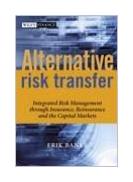|
||
podział tematyczny • wydawnictwa anglojęzyczne podział tematyczny Newsletter: • Zamów informacje o nowościach z wybranego tematu Informacje: • sposoby płatności i dostawy • kontakt • Cookies na stronie • Regulamin zakupów Napisz propresssp@gmail.com |
ALTERNATIVE RISK TRANSFERBANKS E.wydawnictwo: WILEY , rok wydania 2003, wydanie Icena netto: A practical approach to
ART-an alternative method by which companies take on various types of risk Table of Contents PART I: RISK AND THE ART MARKET. 1 Overview of Risk Management. 1.1 Risk and return. 1.2 Active risk management. 1.2.1 Risk management processes. 1.2.2 Risk management techniques. 1.2.3 General risk management considerations. 1.3 Risk concepts. 1.3.1 Expected value and variance. 1.3.2 Risk aversion. 1.3.3 Risk transfer and the insurance mechanism. 1.3.4 Diversification and risk pooling. 1.3.5 Hedging. 1.3.6 Moral hazard, adverse selection and basis risk. 1.3.7 Non-insurance transfers. 1.4 Outline of the book. 2 Risk Management Drivers: Theoretical Motivations, Benefits, and Costs. 2.1 Maximizing enterprise value. 2.2 The decision framework. 2.2.1 Replacement and abandonment. 2.2.2 Costs and benefits of loss control. 2.2.3 Costs and benefits of loss financing. 2.2.4 Costs and benefits of risk reduction. 2.3 Coping with market cycles. 2.3.1 Insurance pricing. 2.3.2 Hard versus soft markets. 2.4 Accessing new risk capacity. 2.5 Diversifying the credit risk of intermediaries. 2.6 Managing enterprise risks intelligently. 2.7 Reducing taxes. 2.8 Overcoming regulatory barriers. 2.9 Capitalizing on deregulation. 3 The ART Market and its Participants. 3.1 A definition of ART. 3.2 Origins and background of ART. 3.3 Market participants. 3.3.1 Insurers and reinsurers. 3.3.2 Investment, commercial, and universal banks. 3.3.3 Corporate end-users. 3.3.4 Investors/capital providers. 3.3.5 Insurance agents and brokers. 3.4 Product and market convergence. PART II: INSURANCE AND REINSURANCE. 4 Primary Insurance/Reinsurance Contracts. 4.1 Insurance concepts. 4.2 Insurance and loss financing. 4.3 Primary insurance contracts. 4.3.1 Maximum risk transfer contracts. 4.3.2 Minimal risk transfer contracts. 4.3.3 Layered insurance coverage. 4.4 Reinsurance and retrocession contracts. 4.4.1 Facultative and treaty reinsurance. 4.4.2 Quota share, surplus share, excess of loss, and reinsurance pools. 4.4.3 Finite reinsurance. 5 Captives. 5.1 Using captives to retain risks. 5.1.1 Background and function. 5.1.2 Benefits and costs. 5.2 Forms of captives. 5.2.1 Pure captives. 5.2.2 Sister captives. 5.2.3 Group captives. 5.2.4 Rent-a-captives and protected cell companies. 5.2.5 Risk retention groups. 5.3 Tax consequences. 6 Multi-risk Products. 6.1 Multiple peril products. 6.2 Multiple trigger products. PART III: CAPITAL MARKETS. 7 Capital Markets Issues and Securitization. 7.1 Overview of securitization. 7.2 Insurance-linked securities. 7.2.1 Overview. 7.2.2 Costs and benefits. 7.3 Structural features. 7.3.1 Issuing vehicles. 7.3.2 Triggers. 7.3.3 Tranches. 7.4 Catastrophe bonds. 7.4.1 Hurricane. 7.4.2 Earthquake. 7.4.3 Windstorm. 7.4.4 Multiple cat peril ILS and peril by tranche ILS. 7.4.5 Bond/derivative variations. 7.5 Other insurance-linked securities. 8 Contingent Capital Structures. 8.1 Creating post-loss financing products. 8.2 Contingent debt. 8.2.1 Committed capital facilities. 8.2.2 Contingent surplus notes. 8.2.3 Contingency loans. 8.2.4 Financial guarantees. 8.3 Contingent equity. 8.3.1 Loss equity puts. 8.3.2 Put protected equity. 9 Insurance Derivatives. 9.1 Derivatives and ART. 9.2 General characteristics of derivatives. 9.3 Exchange-traded insurance derivatives. 9.3.1 Exchange-traded catastrophe derivatives. 9.3.2 Exchange-traded temperature derivatives. 9.4 OTC insurance derivatives. 9.4.1 Catastrophe reinsurance swaps. 9.4.2 Pure catastrophe swaps. 9.4.3 Temperature derivatives. 9.4.4 Other weather derivatives. 9.4.5 Credit derivatives. 9.5 Bermuda transformers and capital markets subsidiaries. PART IV: ART OF THE FUTURE. 10 Enterprise Risk Management. 10.1 Combining risks. 10.1.1 The enterprise risk management concept. 10.1.2 Costs and benefits. 10.2 Developing an enterprise risk management program. 10.2.1 Strategic and governance considerations. 10.2.2 Program blueprint. 10.2.3 Program costs. 10.3 End-user demand. 11 Prospects for Growth. 11.1 Drivers of growth. 11.2 Barriers to growth. 11.3 Market segments. 11.3.1 Finite structures. 11.3.2 Captives. 11.3.3 Multi-risk products. 11.3.4 Capital markets issues. 11.3.5 Contingent capital. 11.3.6 Insurance derivatives. 11.3.7 Enterprise risk management. 11.4 End-user profiles. 11.5 Future convergence. Glossary. Selected References. Index. 420 pages Księgarnia nie działa. Nie odpowiadamy na pytania i nie realizujemy zamówien. Do odwolania !. |


